In today’s digital age, technology offers us more freedom and flexibility than ever before. Imagine being able to access and control your computer remotely, no matter where you are – whether it’s to work from home, troubleshoot a problem, or simply manage files on your desktop. The question many people ask is: Can I control my computer from my phone? The answer is a resounding yes, and this article will guide you through the various ways you can achieve this. Whether you’re using an Android or iOS device, there are a number of tools and apps that allow you to control your computer seamlessly from your phone.
Why Control Your Computer from Your Phone?
Before diving into the how-tos, let’s first explore why you might want to control your computer from your phone. Here are some common scenarios:
- Remote Work and Access: If you’re working from a remote location, controlling your desktop from your phone can provide easy access to files and applications.
- Troubleshooting: If your computer is acting up, you can often diagnose and resolve issues without being physically present.
- Convenience: Whether you’re at a coffee shop, on the go, or lounging on the couch, you can access your computer without needing to be in front of it.
Now that we know why it’s a useful feature, let’s dive into how to make it happen.
How to Control Your Computer from Your Phone
There are several ways to control your computer from your phone, with remote desktop software being the most popular method. Let’s look at some of the best options available.
1. Using Remote Desktop Apps
Remote desktop apps allow you to access your computer’s desktop environment from your phone, essentially turning your phone into a virtual keyboard and mouse. Some of the most popular apps include:
- Google Chrome Remote Desktop
- How it Works: Google Chrome Remote Desktop is a free, user-friendly app that lets you control your computer from any device with the Chrome browser. Simply install the Chrome Remote Desktop extension on your computer and the mobile app on your phone.
- Pros: Free, easy to use, secure, cross-platform.
- Cons: Requires a Google account, might not be as feature-rich as other options.
- TeamViewer
- How it Works: TeamViewer is a powerful remote access tool that allows you to control your computer from anywhere using your smartphone. It works across multiple platforms, including Windows, macOS, and Linux.
- Pros: High-performance, supports file transfer, supports multiple operating systems.
- Cons: Free version is limited for personal use; business use requires a paid license.
- AnyDesk
- How it Works: AnyDesk offers fast and secure remote desktop access, making it ideal for both personal and business use. It also works across multiple platforms, ensuring flexibility.
- Pros: High-quality connections, low latency, and mobile support.
- Cons: Some features are restricted to paid versions.
2. Using Built-in Operating System Features
If you prefer not to download third-party apps, both Windows and macOS come with built-in features that allow remote access.
- Windows Remote Desktop
- How it Works: Windows has a built-in remote desktop feature that allows you to connect to your PC from a phone, provided that you’re running a Professional or Enterprise version of Windows. You can then use the Microsoft Remote Desktop app for Android or iOS.
- Pros: No need for third-party apps if you already have Windows Pro or Enterprise.
- Cons: Requires specific Windows versions; might be tricky to configure for beginners.
- macOS Screen Sharing
- How it Works: If you’re using a Mac, macOS offers a screen-sharing feature that allows you to control your computer remotely. You can use the built-in “Screen Sharing” app or third-party apps like VNC Viewer for mobile access.
- Pros: Built-in feature for Mac users.
- Cons: Limited to macOS devices and users might face some connectivity issues.
3. Using File Sharing Apps
If you’re not looking for full remote desktop control but simply want access to files on your computer, file-sharing apps might be the solution.
- Cloud Storage Solutions (Google Drive, Dropbox, OneDrive)
- How it Works: By storing your files in a cloud storage service, you can access them from your phone without needing to control the computer itself.
- Pros: Easy file access from anywhere, no need for remote desktop setup.
- Cons: Limited to files—no access to full desktop functionality.
- FTP Server Setup
- How it Works: Setting up an FTP server on your computer allows you to access your files remotely through an FTP client app on your phone.
- Pros: Can be a great solution for file management without third-party apps.
- Cons: Requires setup and technical knowledge.
Security Considerations When Controlling Your Computer from Your Phone
While remote access is incredibly useful, it’s essential to consider the security implications. Here are some tips to ensure a secure connection:
- Use Strong Passwords: Make sure your accounts (Google, Microsoft, etc.) have strong, unique passwords to prevent unauthorized access.
- Enable Two-Factor Authentication (2FA): Whenever possible, enable 2FA for an added layer of security.
- Use VPNs: If you’re connecting to your computer over a public network, using a VPN (Virtual Private Network) can help protect your data.
- Update Regularly: Ensure that your operating system and remote access software are regularly updated to patch any vulnerabilities.
Conclusion: Take Control of Your Computer from Anywhere
Controlling your computer from your phone is not only possible but incredibly convenient in today’s connected world. Whether you need to work remotely, troubleshoot issues, or just access files, the options are diverse and accessible. By using remote desktop apps like Google Chrome Remote Desktop, TeamViewer, or built-in operating system features like Windows Remote Desktop, you can easily manage your computer from anywhere.
With the added benefit of increased productivity and convenience, it’s no wonder that more and more people are adopting remote control tools. Now that you know the different ways to control your computer remotely, it’s time to take action! Start by downloading one of the apps mentioned above and enjoy the freedom of managing your computer from your phone.

Caleb Carlson is a contributing writer at Computer Site Engineering, specializing in computer technology, software trends, and hardware innovations. His articles simplify complex tech topics, making them accessible to readers of all levels.





